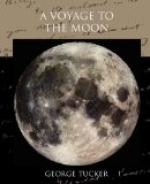After a short interval, I again looked at the moon, and found not only its magnitude very greatly increased, but that it was beginning to present a more beautiful spectacle. The sun’s rays fell obliquely on her disc, so that by a large part of its surface not reflecting the light, I saw every object on it, so far as I was enabled by the power of my telescope. Its mountains, lakes, seas, continents, and islands, were faintly, though not indistinctly, traced; and every moment brought forth something new to catch my eye, and awaken my curiosity. The whole face of the moon was of a silvery hue, relieved and varied by the softest and most delicate shades. No cloud nor speck of vapour intercepted my view. One of my exclamations of delight awakened the Brahmin, who quickly arose, and looking down on the resplendent orb below us, observed that we must soon begin to slacken the rapidity of our course, by throwing out ballast. The moon’s dimensions now rapidly increased; the separate mountains, which formed the ridges and chains on her surface, began to be plainly visible through the telescope; whilst, on the shaded side, several volcanoes appeared upon her disc, like the flashes of our fire-fly, or rather like the twinkling of stars in a frosty night. He remarked, that the extraordinary clearness and brightness of the objects on the moon’s surface, was owing to her having a less extensive and more transparent atmosphere than the earth: adding—“The difference is so great, that some of our astronomical observers have been induced to think she has none. If that, however, had been the case, our voyage would have been impracticable.”
After gazing at the magnificent spectacle, with admiration and delight, for half an hour, the Brahmin loosed one of the balls of the lunar metal, for the purpose of checking our velocity. At this time he supposed we were not more than four thousand miles, or about twice the moon’s diameter, from the nearest point of her surface. In about four hours more, her apparent magnitude was so great, that we could see her by looking out of either of the dark side-windows. Her disc had now lost its former silvery appearance, and began to look more like that of the earth, when seen at the same distance. It was a most gratifying spectacle to behold the objects successively rising to our view, and steadily enlarging in their dimensions. The rapidity with which we approached the moon, impressed me, in spite of myself, with the alarming sensation of falling; and I found myself alternately agitated with a sense of this danger, and with impatience to take a nearer view of the new objects that greeted my eyes. The Brahmin was wholly absorbed in calculations for the purpose of adjusting our velocity to the distance we had to go, his estimates of which, however, were in a great measure conjectural; and ever and anon he would let off a ball of the lunar metal.




